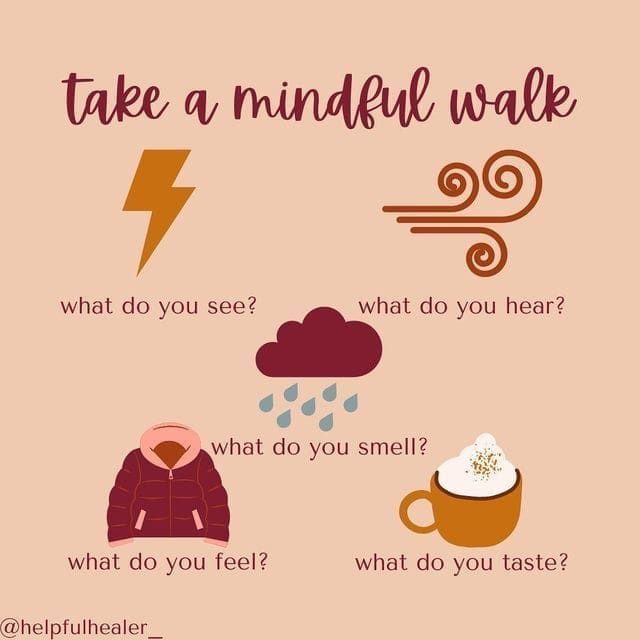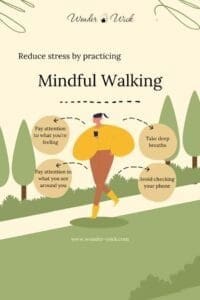Mindful walking practice turns an everyday activity into a powerful tool for relaxation and awareness. By focusing on each step, your breath, and the sensations in your body, you can calm your mind and connect with the present moment. Whether done indoors or outside, mindful walking is an easy way to bring mindfulness into your daily routine.
What is Mindful Walking?
Mindful walking practice is a gentle, accessible way to bring mindfulness into your daily routine. By focusing on each step, your breath, and your surroundings, this mindful walking practice helps reduce stress, improve concentration, and enhance your overall well-being. Whether you’re walking in nature or through your neighborhood, mindful walking practice can ground you in the present and support mental clarity, one step at a time.
Benefits of Mindful Walking
Incorporating mindful walking into your daily routine can bring numerous benefits, both mentally and physically. Here’s a quick overview:
| Benefit | Description |
|---|---|
| Stress Reduction | Walking mindfully helps mitigate anxiety and stress. |
| Better Focus | Improves concentration, enhancing your daily activities. |
| Enhanced Mood | Regular practice can lead to a more positive mindset. |
| Improved Physical Fitness | Promotes fitness while also aiding in mental clarity. |
| Heightened Awareness | Increases your awareness of your body and surroundings. |
By being more in tune with your body and thoughts, you can enjoy a greater sense of well-being. Let’s take a deeper dive into how to practice mindful walking effectively.
Getting Started
Mindful walking is accessible to everyone, regardless of your experience level with mindfulness or walking. You just need a few simple steps to begin. These steps will help you build a mindful walking practice that feels natural and sustainable.
Choose Your Environment
Start by selecting a suitable environment. It can be a quiet park, a serene beach, or even a calm street in your neighborhood. Look for a space where you feel safe and can walk freely without distractions.
Dress Comfortably
Make sure you wear comfortable clothes and shoes that allow for free movement. When you’re comfortable, you’re more likely to enjoy the practice and focus on the experience rather than on discomfort.
Set Your Intention
Before you start, take a moment to set an intention for your walk. It could be as simple as wanting to feel more relaxed or to connect with nature. Setting an intention helps guide your thoughts during the walk and keeps you focused on the moment.
The Practice of Mindful Walking
Now that you have your environment, attire, and intention set, let’s dive into the actual practice of mindful walking.
Begin with Awareness of Your Breath
As you start walking, take a few moments to focus on your breath. Inhale deeply through your nose, allowing your belly to expand, and then exhale slowly through your mouth. This simple act can ground you and prepare your mind for a more aware experience.
Connect with Your Body
Notice how your body feels as you walk. Pay attention to the sensations in your feet as they make contact with the ground, the movement of your legs, and the way your arms swing. Observe the rhythm of your walk and how your body moves fluidly with each step.
Engage Your Senses
Mindful walking is also about engaging your senses. Take a moment to soak up your surroundings—the colors of the trees, the sounds of birds chirping, or even the sound of your shoes on the path. When you engage your senses, you draw your focus away from distracting thoughts and into the present. Using your senses fully is what transforms a walk into a mindful walking practice.
| Sense | How to Engage |
|---|---|
| Sight | Notice the colors and shapes around you. |
| Sound | Listen to the sounds of nature or the bustle of the city. |
| Touch | Feel the ground under your feet and the breeze on your skin. |
| Smell | Inhale the fresh air or the scents of flowers and trees. |
| Taste | If you have water or a snack, taste it mindfully when you take a break. |
Acknowledge Your Thoughts
It’s natural for your mind to wander while walking. When a thought arises, simply acknowledge it without judgment, then gently bring your awareness back to the act of walking. Treat each thought like a passing cloud without holding onto it.
Use a Mantra or Counting
Some people find it helpful to use a mantra or number sequence to keep their focus. You might choose a simple phrase like “I am present” or count your steps—one for the left foot, two for the right, repeating as needed. This practice can help anchor you in the present.
Length of Your Walk
While mindful walking can be done for any length of time, starting with 15-20 minutes can be ideal for beginners. As you grow more comfortable, you can extend your walks to 30 minutes or even an hour. The key is to listen to your body and find a duration that feels right for you.
Incorporating Mindful Walking into Your Routine
Making mindful walking a regular part of your life can amplify its benefits. Here are some great ways to incorporate this practice into your daily routine.
Morning Walks
Kickstart your day with a morning walk. It can energize you, set a positive tone for the day, and help you approach challenges with a fresh mindset.
Lunchtime Breaks
Instead of staying sedentary during your lunch break, consider taking a mindful walk. It can boost your afternoon productivity and mood by giving you a mental reset.
Evening Wind-Down
Use evening walks to reflect on your day. As you stroll, think about what went well and what you loved most about your day. It’s a great way to practice gratitude before bedtime.
Group Walking
Consider inviting friends or family to join you in mindful walking. Not only can you enjoy each other’s company, but you can also share the experience, support each other in practicing mindfulness, and increase motivation.
Challenges of Mindful Walking
While mindful walking can be a fulfilling practice, you may encounter some challenges along the way. Understanding these can help you navigate through them more easily.
Distractions
It’s easy to get distracted by your surroundings or your thoughts. If this happens, gently remind yourself to return to your breath, your body, or your intention.
Restlessness
At times, you might feel restless or uneasy while walking mindfully. This is completely normal, especially as you begin to practice. Remember that mindful walking is a skill that improves with regular practice.
Frustration with Focus
You may find it difficult to concentrate at first. This is all part of the learning process. Keep practicing, and you will gradually enhance your ability to remain present with your thoughts and surroundings.
Advanced Techniques for Mindful Walking
Once you feel comfortable with the basics, you might want to explore some advanced techniques to deepen your experience of mindful walking.
Walking Meditation
Walking meditation is a more structured approach where you focus entirely on the act of walking as a form of meditation. You’ll move slowly and purposefully, pairing each step with your breath.
Nature Immersion
Take your mindful walking practice into nature. Whether it’s a local park or a hiking trail, nature can enhance your experience through its calming environment and intricate details.
Guided Mindful Walking
You could also listen to guided mindful walking sessions, available through various apps and platforms. These can lead you through the process, helping you maintain focus and clarity.
Reflecting on Your Practice
After your walks, take a moment to reflect on your experience. This can enhance your mindfulness journey and help you identify any areas for improvement.
Journaling
Consider keeping a journal to document your thoughts and feelings after each walk. Writing about your experiences can provide deeper insights into your practice and help you track your progress over time.
Create a Mindfulness Goals List
To hold yourself accountable, craft a list of mindfulness goals. These could include regular walking times, new locations to explore, or meditation goals. Setting intentions can motivate you to maintain your practice.
Conclusion
Mindful walking is more than just exercise; it’s a rich practice that enhances your connection to the present moment. It invites you to slow down, breathe, and truly experience life step by step. With patience and regular practice, you’ll find that this simple activity builds not just physical health but also mental clarity and emotional well-being. So, why not take that first step today? So, why not begin your mindful walking practice today and take that first step with intention?
Disclaimer
The content is purely informative and educational in nature and should not be construed as medical advice. Please use the content only in consultation with an appropriate certified medical or healthcare professional


